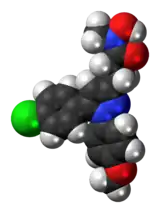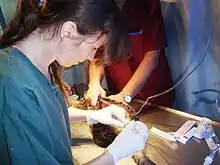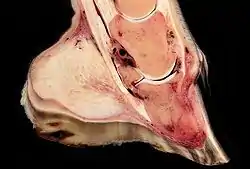Tepoxalin
Tepoxalin, marketed under the brand name Zubrin[1] among many others, is a non-steroidal anti-flammatory drug (NSAIDs) generally used in veterinary medicine to reduce swelling in animals with osteoarthritis.[1] In rare circumstances, Tepoxalin can also be used in human pharmacology to relieve pain caused by musculoskeletal conditions such as arthritis and hip dysplasia.[2]
 | |
 | |
| Clinical data | |
|---|---|
| AHFS/Drugs.com | International Drug Names |
| Routes of administration | Oral |
| ATCvet code | |
| Legal status | |
| Legal status |
|
| Identifiers | |
| |
| CAS Number | |
| PubChem CID | |
| ChemSpider | |
| UNII | |
| KEGG | |
| ChEBI | |
| CompTox Dashboard (EPA) | |
| ECHA InfoCard | 100.166.553 |
| Chemical and physical data | |
| Formula | C20H20ClN3O3 |
| Molar mass | 385.85 g·mol−1 |
| 3D model (JSmol) | |
| |
| |
| | |
In 1997, the drug was patented for veterinary use, replacing isoxazole for treating inflammation.[3] In 2017, the drug was withdrawn from the American market and can no longer be administered in the United States.[3]
Tepoxalin (C20H20ClN3O3) is produced by the condensation of a carboxyl group and an amino group.[1] There are many perspectives on whether the consumption of Tepoxalin on its own is more effective than combining it with other antihistamines, but when applied in veterinary medicine, Tepoxalin is regularly synthesised with other antihistamines.[1]
Approval
The Committee for Medicinal Products for Veterinary Use (CVMP) approves Tepoxalin to be used as a drug for animals to reduce inflammation and pain control.[3] Additionally, in Europe, Tepoxalin is approved by the EU Community Register of Medicinal Products and European Medicines Agency in the product categories of Veterinary Drug and Veterinary Pharmacotherapeutic Group categorised into the Musculo-skeletal System subcategory.[4]
Tepoxalin was first medically approved in the United States in 1998. The drug was taken off the market in 2017 and cannot be administered in the United States.[4] However, it still has Food and Drug Administration (FDA) approval.[4]
On the 4 September 2017, an application was submitted to the European Medicines Agency (EMEA) asking for an extension of marketing authorisation for Tepoxalin.[3] The EMEA criticised the quality, safety and efficacy data submitted and the application was declined.[3]
Pharmacology and biochemistry
Tepoxalin (C20H20ClN3O3) is produced by the condensation of a carboxyl group of 3-[5-(4-chlorophenyl)-1-(4-methoxyphenyl)pyrazol-3-yl] propanoic acid and an amino group of N-methylhydroxylamine.[3] Condensation is a chemical reaction in which two or more molecules merge into form a larger molecule, with the simultaneous loss of a small molecule such as water or methanol.[3]
The drug works as a nonsteroidal anti-inflammatory drug (NSAID) to suppress both cyclooxygenase and lipoxygenase.[5] Cyclooxygenase and lipoxygenase produces COX-2 and 5-LOX enzymes respectively, these enzymes activate the swelling and inflammation that causes pain in animals. Tepoxalin is an inhibitor which blocks out theses enzymes to reduce the swelling and inflammation. Additionally, it can be also used as a “dual-action” inhibitor to additionally suppress leukotriene and prostaglandin (E2).[5]Leukotriene and prostaglandin are also enzymes that activates inflammation in the body.[6]
Tepoxalin is produced into white, flavourless tablets that rapidly disintegrate when consumed by an animal. These tasteless tablets are branded as Zubrin on the market.[4] After consumption, Zubrin has a half-life of 120 minutes in the plasma (cytoplasm; the main part of the capsule) itself, whereas the entire metabolite (entirety of the capsule) has a half-life of 13 hours.[4] It is therefore usually prescribed to be taken once a day.[3]
Canine and feline uses
Available in an oral formulation, Tepoxalin is used to treat osteoarthritis in canine and feline species.[4] The use of Tepoxalin was more effective than the NSAID (nonsteroidal anti-flammatory drug), carprofen when administered in canines. As a result, the usage of carprofen was replaced with Tepoxalin in 1998.[7]
Tepoxalin can only be administered to dogs that weigh 3 pounds (~1.36kgs) or larger at a dose of 10–20 mg/kg at a daily schedule.[6] The approximate duration of complete treatment is at most 14 days.[1] If treated for a prolonged period of time (more than 180 days), it may result in gastrointestinal irritation and gastric ulceration. The plasma concentration of Tepoxalin when administered varies between every dog, so there is no difference in administering between fed or fasted canines.[1] However, there is a low water solubility and a high fat solubility, it is often prescribed to fed canines rather than fasted as this is more effective for Tepoxalin.[7]
In felines, Tepoxalin has an inhibitory action on COX-1 and 5-LOX enzymes in contrary in canines, Tepoxalin causes inhibition for COX-2 and 5-LOX enzymes. For felines, Tepoxalin is prescribed in doses between 5 and 10 mg/kg once daily for 3 consecutive days. Additionally, Tepoxalin can only be prescribed to felines over the weight of 3 pounds (~1.36kgs).[8] When Tepoxalin is administered in cats, a drunken-like state afflicting the central nervous system has been recorded on rare occasions.[8]

Equine use
When administered for horses, the formulation can be in a paste, powder or feed-in form which can be fed orally or it can be injected through the vein but no other place in the equine body, as it can cause tissue damage.[9] However, if Tepoxalin is injected repeatedly in the vein for a prolonged period of time, it can also cause tissue damage and edema (trapped fluid in tissue).[9]
Chronic inflammatory diseases are the most common diseases in horses. Phenylbutazone was formerly used as treatment, but when administered to horses at high doses, it can develop ulcers of the glandular stomach, oral cavity and colon.[10] Due to the major adverse effects of phenylbutazone, the replacement for Tepoxalin was made to be administered to horses to reduce muscular pain in 2003.[9]
In horses, the drug is intravenously administered at 10 mg/kg on a daily dose for 10 days respectively.[9] Doses may be doubled or tripled to treat severe pain, such as laminitis. The plasma (cytoplasm; the main part of the capsule) half-life of Tepoxalin is 4–8 hours, although the inflammatory entire metabolite (entirety of the capsule) half-life is 24 hours, so single dosing is more efficient for horses. When given at reasonable doses, the drug is non-toxic even when used repeatedly.[9]

Adverse effects
There is a high incidence of adverse reports received for Tepoxalin by the Centre of Veterinary Medicine.[11] Common side effects of the consumption of Tepoxalin include vomiting, diarrhoea, blood in faeces, loss of appetite, fatigue, thirst, an increase in urination and behavioural changes.[7] In older and sensitive animals, loss of hair and abrasion of the skin may occur.[10] The drug cannot be used by animals during breeding, pregnancy or lactation as the drug can affect the foetus or infants.[10] In animals with a history of internal bleeding or low blood pressure, it can result in perforation of the stomach walls or intestinal mucosa.[10]
Older dogs are more prone to the adverse effects.[11] When administered to male canines, there are no effects to the male's fertility. However, when a female canine is treated during the organogenetic period, it may result in embryo foetal toxicity.[10] The outcome of this toxicity is a major reduction in foetal weight, incomplete formation of various bones and other skeletal malformations. In extreme cases, it can result in the death of the foetus.[10]
Overdose can occur if administered in an excessive large dose. Signs of overdose or toxicity in canines and felines include tremors, seizures, abnormal behaviour, vomiting and weakness.[3]
References
- Papich MG (2016). "Tepoxalin". Saunders Handbook of Veterinary Drugs Small and Large Animal (4th ed.). Elsevier. p. 762. ISBN 978-0-323-24485-5.
- "epoxalin (Zubrin®)". PetCoach. Petco Animal Supplies Stores, Inc.
- Murray WV, Hadden SK (2010-08-20). "ChemInform Abstract: A Facile Synthesis of Tepoxalin, 5-(4-Chlorophenyl)-N-hydroxy-1- (4-methoxyphenyl)-N-methyl-1H-pyrazole-3-propanamide". ChemInform. 24 (13): no. doi:10.1002/chin.199313189.
- "Special issue". American Journal of Veterinary Research. 69 (12). December 2008. doi:10.2460/ajvr.2008.69.issue-12.
- Kahan BD (August 1998). "FTY720: a new immunosuppressive agent with novel mechanism(s) of action". Transplantation Proceedings. 30 (5): 2210–2213. doi:10.1016/s0041-1345(98)00593-4. ISSN 0041-1345. PMID 9723444.
- Carey FA, Sundberg RJ (2002). "Reaction of Carbon Nucleophiles with Carbonyl Groups". =Advanced Organic Chemistry. Advanced Organic Chemistry. Kluwer Academic Publishers. pp. 57–139. doi:10.1007/0-306-47380-1_2. ISBN 0-306-46244-3.
- Lothrop CD (1995). "Veterinary medical specialization". Veterinary Medical Specialization - Bridging Science and Medicine. Advances in Veterinary Science and Comparative Medicine. 39. Elsevier. pp. 141–190. doi:10.1016/s0065-3519(06)80019-4. ISBN 978-0-12-039240-7. PMID 8578975.
- "Pink Pages 4+5: Further qualifications in feline medicine". Journal of Feline Medicine & Surgery. 9 (4): VIII–IX. August 2007. doi:10.1016/s1098-612x(07)00128-3. ISSN 1098-612X. PMID 28058970.
- Giorgi M, Cuniberti B, Ye G, Barbero R, Sgorbini M, Vercelli C, et al. (October 2011). "Oral administration of tepoxalin in the horse: a PK/PD study". Veterinary Journal. 190 (1): 143–9. doi:10.1016/j.tvjl.2010.09.013. hdl:2318/80291. PMID 21036634.
- "Acta Orthopaedica Scandinavica 1976". Acta Orthopaedica Scandinavica. 47 (1): 1–2. January 1976. doi:10.3109/17453677608998964. ISSN 0001-6470.
- New Zealand Veterinary Association. (2002). New Zealand veterinary journal : the complete archive in full-text on CD-ROM. New Zealand Veterinary Association. OCLC 946530381.